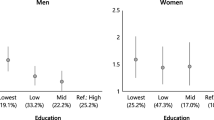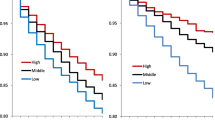Abstract
The objective of this study was to examine educational levels and employment status as independent determinants of overall and cause-specific mortality in a Japanese population. Participants were 4,301 men and 6,780 women in a multi-center community-based prospective study, and data of the baseline survey was collected between 1992 and 1995. The participants were followed up until December 31, 2002 (the average follow-up period was 9.17 years). Early termination of education was associated with an increased risk of mortality from all causes for both men and women. This tendency was more prominent in women aged 59 and younger (hazard ratio (HR) = 3.82, 95% confidence interval (CI): 1.18–12.34), after adjusting for confounding factors using the Cox proportional hazard models. Similar trends were shown for men; specifically, cardiovascular disease mortality for all men was increased by early termination of education (HR = 2.97, 95% CI: 1.17–7.52) compared to later termination. For employment status, unemployed men showed increased mortality from all causes compared to white-collar workers (HR = 1.51, 95% CI: 1.00–2.28). Female farmers and forestry workers showed reduced mortality from all causes compared to white-collar workers (HR = 0.55, 95% CI: 0.33–0.93). Male farmers and forestry workers also showed reduced mortality from cardiovascular diseases compared to white-collar workers (HR = 0.34, 95% CI: 0.14–0.82). Educational level and employment status may affect mortality for Japanese women and men.
Similar content being viewed by others
Explore related subjects
Discover the latest articles and news from researchers in related subjects, suggested using machine learning.References
Schellekens J (1989) Mortality and socio-economic status in two eighteenth-century Dutch villages. Popul Stud 43: 391–404
Davey Smith G, Bartley M, Blane D (1990) The Black Report on socioeconomic inequalities in health 10 years on. Br Med J 301: 373–377
Davey Smith G, Carroll D, Rankin S (1992) Socio-economic differentials in mortality: Evidence form Glasgow graveyards. Br Med J 305: 1554–1557
Davey Smith G, Hart C, Hole D, et al. (1998) Education and occupational social class: Which is the more important indicator of mortality risk? J Epidemiol Comm Health 52: 153–160
Kunst AE, Mackenbach JP. (1994) The size of mortality differences associated with educational level in nine industrialized countries. Am J Public Health 84: 932–937
Liberatos P, Link BG, Kelsey JL. (1988) The measurement of social class in epidemiology. Epidemiol Rev 10: 87–121
Davey Smith G, Shipley MJ, Rose G. (1990) The magnitude and causes of socio-economic differentials in mortality: Further evidence from the Whitehall study. J Epidemiol Comm Health 44: 260–265
Davey Smith G, Blane D, Bartley M. (1994) Explanations for socioeconomic differentials in mortality: Evidence from Britain and elsewhere. Eur J Pub Health 4: 131–144
Fukuda Y, Nakamura K, Takano T (2004) Municipal socioeconomic status and mortality in Japan: Sex and age differences, and trends in 1973–1998. Soc Sci Med 59: 2435–2445
Fukuda Y, Nakamura K, Takano T. (2005) Cause-specific mortality differences across socioeconomic position of municipalities in Japan, 1973–1977 and 1993–1998: Increased importance of injury and suicide in inequality for ages under 75. Int J Epidemiol 34: 100–109
Kunst AE (2005) Commentary: Using geographical data to monitor socioeconomic inequalities in mortality: Experiences from Japanese studies. Int J Epidemiol 34: 110–112
Fujino Y, Tamakoshi A, Iso H, et al. (2005) A nationwide cohort study of educational background and major causes of death among the elderly population in Japan. Prev Med 40: 444–451
Iwasaki M, Otani T, Ohta A, Sasazawa Y, Kuroiwa M, Suzuki S. (2002) Rural-urban differences in sociodemographic, social network and lifestyle factors related to mortality of middle-aged Japanese men from the Komo-Ise cohort study. J Epidemiol 12(2): 93–104
Mathers CD, Schofield DJ. (1998) The health consequences of unemployment: The evidence. Med J Australia 16: 178–182
Kelly GP. (1990) Education and equality: Comparative perspective on the expansion of education and women in the post-war period. Int J Educ Dev, 10 131–141
Ishikawa S, Gotoh T, Nago N, Kayaba K. (2002) The Jichi Medical School (JMS) Cohort Study: Design, baseline data and standardized mortality ratios. J Epidemiol 12: 408–417
Statistic Bureau, Management and Coordination Agency, Government of Japan. Statistical Observations of Shi, Ku, Machi, Mura, 2000 [in Japanese]
Tsutsumi A, Kayaba K, Yoshimaru M, Sawada M, shikawa S, Sakai K, Gotoh T, Nago N, The Jichi Medical School Cohort Study Group. Association between job characteristics and health behaviors in Japanese rural workers. Int J Behav Med 2003; 10: 125–142
Kennel WB, Sorlie P. (1979) Some health benefits of physical activity: The Framingham study. Arch Int Med 139: 857–861
Elo IT, Preston SH. (1996) Educational differentials in mortality: United States, 1979–1985. Soc Sci Med 42: 47–57
Burmeister LF, Morgan DP. (1982) Mortality in Iowa farmers and farm laborers, 1971–1978. J Occup Med 24: 898–900
Gallagher RP, Threlfall WJ, Spinelli JJ, Band PR. (1984) Occupational mortality patterns among British Columbia farm workers. J Occup Med 26: 906–908
Notkola VJ, Husman KH, Laukkanen VJ. (1987) Mortality among male farmers in Finland during 1979–1983. Scand J Work Environ Health 13: 124–128
Nakaya T, Dorling D. (2005) Geographical inequalities of mortality by income in two developed island countries: A cross-national comparison of Britain and Japan. Soc Sci Med 60: 2865–2875
Otake F. 90 nendai no syotoku-kakusa (income inequality during 1990s). The Monthly Journal of the Japan Institute of Labour 2000; 480: 2–11 [in Japanese]
Hasegawa T (2001) Japan: historical and current dimensions of health and health equity. In: Evans T, Whitehead M, Diderichsen F, Bhuiya A, Wirth M (eds) Challenging Inequalities in Health: From Ethics to Action. Oxford University Press, Oxford, pp. 90–103
Notkola VJ, Martikainen P, Leino PI. (1993) Time trends in mortality in forestry, construction workers in Finland 1970–1985 and impact of adjustment for socioeconomic variables. J Epidemiol Comm Health 47: 186–191
Davey Smith G, Ben-Shlomo Y. (1997) Geographical and social class differentials in stroke mortality—the influence of early-life factors. J Epidemiol Comm Health 51: 134–137
Hinkle LE Jr., Whitney LH, Lehman EW, et al. (1968) Occupation, education, and coronary heart disease. Risk is influenced more by education and background than by occupational experiences, in the Bell System. Science 161: 238–246
Qureshi AI, Suri MFK, Saad M, Hopkins LN. (2003) Educational attainment and risk of stroke and myocardial infarction. Med Sci Monit 9: CR466–CR473
Backlund E, Sorlie PD, Johnson NJ. (1999) A comparison of the relationships of education and income with mortality: The national longitudinal mortality study. Soc Sci Med 49: 1373–1384
Krieger N, Williams DR, Moss NE. (1997) Measuring of social class in US public health research. Ann Rev Pub Health 18: 341–378
Muller A (2002) Education, income inequality, and mortality: A multiple regression analysis. Br Med J 324: 23–25
Sorlie PD, Blacklund E, Keller JB. (1995) U.S Mortality by economic, demographic, and social characteristics: The National Longitudinal Mortality Study. Am J Public Health 85: 949–956
Author information
Authors and Affiliations
Corresponding author
Additional information
Funding: The Foundation for the Development of the Community, Tochigi, Japan.
Appendix
Appendix
The Jichi Medical School Cohort Study Group: Hidetaka Akiyoshi (Department of Pediatrics, Fukuoka University School of Medicine), Yoko Amagai (Department of Community and Family Medicine, Jichi Medical School, Tochigi), Tomohiro Deguchi (Akaike Town Hospital, Fukuoka), Yuriko Doi (Department of Epidemiology, National Institute of Public Health, Saitama), Yasuyuki Fujita (Department of Public Health, Shimane University), Makoto Furuse (Department of Radiology, Jichi Medical School, Tochigi), Tadao Gotoh (Wara National Health Insurance Hospital, Gifu), Atsushi Hashimoto (Aichi Prefectural Aichi Hospital, Aichi), Shinya Hayasaka, (Department of Community and Family Medicine, Jichi Medical School, Tochigi), Noriko Hayashida, Jun Hiraoka (Tako Central Hospital, Chiba), Masahiko Hosoe (Gero Hot-Spring Hospital, Gifu), Masahiro Igarashi (Igarashi Child Clinic), Shizukiyo Ishikawa (Department of Community and Family Medicine, Jichi Medical School, Tochigi), Yoshihisa Ito (Department of Laboratory Medicine, Asahikawa Medical College, Hokkaido), Eiji Kajii (Department of Community and Family Medicine, Jichi Medical School, Tochigi), Kazuomi Kario (Department of Cardiology, Jichi Medical School, Tochigi), Kazunori Kayaba (Epidemiology and Public Health, School of Health and Social Services, Saitama Prefectural University, Saitama), Nobuya Kodama (Sakugi Clinic, Hiroshima), Hitoshi Matsuo (Gifu Prefectural Gifu Hospital, Gifu), Hideki Miyamoto (former Department of Community and Family Medicine, Jichi Medical School, Tochigi), Takeshi Miyamoto (former Okawa Komatsu National Health Insurance Clinic, Kochi), Masafumi Mizooka (Kamagari National Health Insurance Clinic, Hiroshima), Shinichi Muramatsu (Department Neurology, Jichi Medical School, Tochigi), Naoki Nago (Tsukude Health Insurance Clinic, Aichi), Yosikazu Nakamura (Department of Public Health, Jichi Medical School, Tochigi), Takafumi Natsume (Oyama Municipal Hospital, Tochigi), Atsuko Sadakane (Akaike Town Hospital, Fukuoka), Tomohiro Saegusa (Sakuma National Health Insurance Hospital, Shizuoka), Kenichiro Sakai (Akaike Town Hospital, Fukuoka), Machi Sawada (Agawa Osaki National Health Insurance Clinic, Kochi), Kazuyuki Shimada (Department of Cardiology, Jichi Medical School, Tochigi), Yoshihiro Shibano (Saiseikai Iwaizumi Hospital, Iwate), Masayuki Shimizu (Iizuna Public Hospital, Nagano), Shuzo Takuma (Akaike Town Hospital, Fukuoka), Junji Tsumoto (Department of Community and Family Medicine, Jichi Medical School, Tochigi), Akizumi Tsutsumi (Okayama University School of Medicine and Dentistry, Okayama), Kaname Tsutsumi (Kyushu International University, Fukuoka), Kishio Turuda (Takasu National Health Insurance Clinic, Gifu), Fumihiro Uno (Tako Central Hospital, Chiba), Seishi Yamada (Wara National Health Insurance Hospital, Gifu), Takashi Yamada (Kuze Clinic, Gifu), Rika Yamaoka (Awaji-Hokudan Public Clinic, Hyogo), Hiroshi Yanagawa (Saitama Prefectural University, Saitama), and Manabu Yoshimura (Kuze Clinic, Gifu).
Rights and permissions
About this article
Cite this article
Hirokawa, K., Tsutusmi, A. & Kayaba, K. Impacts of educational level and employment status on mortality for Japanese women and men: the Jichi Medical School cohort study. Eur J Epidemiol 21, 641–651 (2006). https://doi.org/10.1007/s10654-006-9049-2
Received:
Accepted:
Published:
Issue Date:
DOI: https://doi.org/10.1007/s10654-006-9049-2




